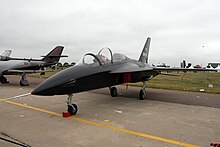KB SAT SR-10
From Wikipedia, the free encyclopedia
The KB SAT SR-10 is a prototype Russian single-engine jet trainer aircraft, fitted with forward-swept wings. It first flew in 2015, and is being offered to the Russian Air Force and for export.
Design and development[edit]
The Russian design bureau KB SAT (Sovremyenne Aviatsyonne Tekhnologii - Modern Aircraft Technologies) began work on a single-engine jet trainer and sport aircraft, the SR-10, in 2007, displaying a mockup at the MAKS airshow at Zhukovsky in August 2009. The SR-10 is a mid-wing monoplane of all-composite construction, with a wing swept forward at an angle of 10 degrees. The crew of two sit in a tandem cockpit. It is powered by a single turbofan, with a Ivchenko AI-25V fitted in the prototype, but more modern Russian engines, such as the NPO Saturn AL-55are proposed for production aircraft.[1]
The SR-10 was offered to meet a 2014 requirement for a basic trainer for the Russian Air force, but was rejected in favour of the Yakovlev Yak-152, a proposed turboprop trainer. Despite this setback, KB SAT continued to develop the SR-10, proposing it as an intermediate trainer between the Yak-152 and the Yakovlev Yak-130 advanced trainer and for export. The first prototype SR-10 made its maiden flight on 25 December 2015.[1]
Specifications (SR-10)[edit]
Data from Russia's New Jet Trainer[1]
General characteristics
- Crew: 2
- Length: 9.59 m (31 ft 6 in)
- Wingspan: 8.40 m (27 ft 7 in)
- Height: 3.55 m (11 ft 8 in)
- Gross weight: 2,400 kg (5,291 lb)
- Max takeoff weight: 2,700 kg (5,952 lb)
- Powerplant: 1 × Ivchenko AI-25V turbofan, 16.87 kN (3,790 lbf) thrust
Performance
- Maximum speed: 900 km/h (559 mph; 486 kn)
- Cruise speed: 520 km/h (323 mph; 281 kn)
- Range: 1,500 km (932 mi; 810 nmi)
- Service ceiling: 6,000 m (20,000 ft)
- g limits: +10/-8
- Rate of climb: 60 m/s (12,000 ft/min)
References[edit]
- Butowski, Piotr (February 2016). "Russia's New Jet Trainer". Air International. Vol. 90 no. 2. p. 15. ISSN 0306-5634.
External links[edit]
| Wikimedia Commons has media related to SAT SR-10. |
- "New Russian forward-swept wing jet trainer has made its first flight. And here’s the video". The Aviationist. 2 January 2016.
- "Russia’s 1st forward-swept wing training aircraft performs maiden flight (VIDEO)". Russia Today. 1 January 2016.
- KB-SAT official site (in Russian)


No comments:
Post a Comment